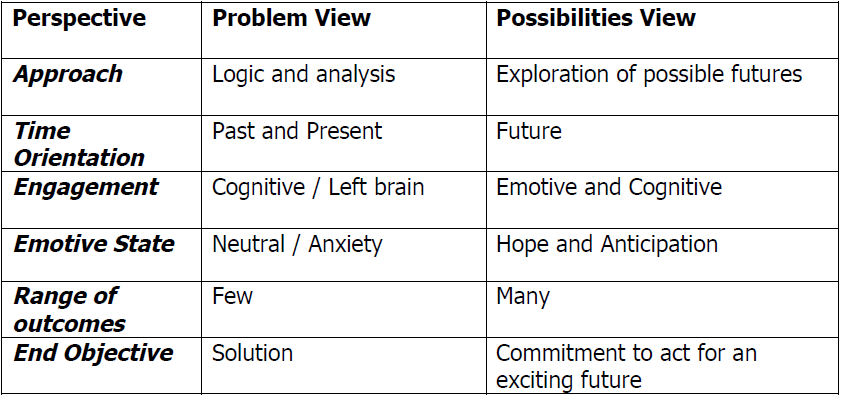Problems cannot be solved by the same level of thinking that created them.
– Albert Einstien
Reframing Perspective from Problems to Possibilities
A Case Example
A case example may illustrate this better. While facilitating a group which was going through a bad phase in terms of performance, the group started the day by beginning to focus on the long list of problems they were having vis-avis the organization, the external environment, the head quarters and so on.
By the end of the hour, the group was staring at the list, low on energy, overwhelmed with the enormity of the issues they faced.
The facilitator, sensing this, for the next exercise asked the group to visualize the possible positive futures for the team. After each one had individually visualized this and the sharing among the group started, the energy, suddenly shifted, as participant after participant shared their stories and visuals of the group’s future. Slowly, the group started to align towards a realistic future that was exciting and that they were willing to move towards. The meeting ended up with clarity, alignment and commitment from the group towards a future course of action.
At the end of the session, the leader of the group looked up a the list of problems they had initially listed and remarked
when I look back at the list, I realize that many of these issues, in view of our future, is irrelevant and many now seem over amplified. Of those that are left, most seem within our control to solve.
Coaching Applications
As a coach one can apply this perspective when working with clients in two different ways:
1. De-amplifying the problem in view of the big picture and the future: Often, when clients bring up problems and issues and get bogged down by them, the possibilities perspective helps them get in touch with the bigger picture and understand where the problem fits in. Exploration by its very nature throws up multiple options. Sometimes, this alone is enough to de-amplify the problem. At others, the client begins to see the problem in perspective and there is immediate drop in the levels of anxiety of the client. It also opens up new views and means of dealing with the problem at hand as well.
Some useful questions to reframe the client view could be:
a. If you were to visualize a future, which is positive and inspiring and motivating for you, how would it look like?
Describe it in detail. What do you see? What do you hear?
b. What would make this future move from potential to reality?
2. Moving the client from an anxious to a calm and energized state: In engaging with a problem, the emotional state of the client is usually in a stressed and worried state. By reframing the perspective, there is an immediate toning down of the client’s emotional state and moves from agitation towards being more hopeful and energized.
Some useful questions to explore and reframe his emotional state could be as follows:
a. What are the feelings associated with your visual of the future? What makes it so?
b. What are the ways of sustaining this emotional reality associated with the future?
Some closing reflections
The tool must be used by the coach when he senses that the client is bogged down and the problem view is limiting his thought and ability to act. It can be used in conjunction with other tools such as visualization, brainstorming, drawing, modeling etc. It can have a huge impact on the client by putting the problem in context of the big picture and thereby helping him move forward in a positive frame of mind. It also can help move his state to one of positive energy and flow. Needless to say the reframing must be accompanied by the coach adopting the right tone of voice, energy and body language.
